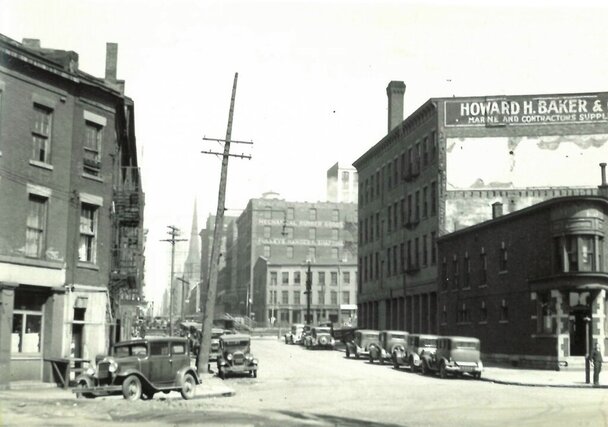
A view up Pearl Street, from the intersection with Commercial Street, ca. 1930.
Western New York Heritage collection, gift of Mike Miranda
Back in January, we were very fortunate to receive an unexpected packet of tiny old photos from Mike Miranda, whose late wife Alice was a long-time and much beloved board member of Western New York Heritage.
Apparently, the stack of photos—most of them appearing to be from the late 1920s and early 1930s—came to him back in the 1950s and represent an effort to document portions of downtown Buffalo by the Rumsey family, for a project that seemingly never came to fruition.
Whatever their purpose, they represent an incredible time capsule of streetscapes that are now largely gone—victims of urban renewal and modernization in most cases. While the buildings and streets in some images are obvious, others are going to take more research to pin down. But what an adventure it will be.
In the meantime, we wanted to share a single sample of the collection for this issue’s installment of Endnotes. After a fair amount of digging into atlases, city directories and such, we determined that it shows a view looking north on Buffalo’s Pearl Street, at the intersection of Commercial Street, ca. 1930.
The blocks on the right have long been obliterated by the construction of more recent structures, including Memorial Auditorium (now, itself, a memory) and what is now the Seneca One complex. But the immortal spire of St. Paul’s Episcopal Cathedral in the background provides an unmistakable reference point.
Based on information from a 1915 Buffalo atlas in our collection, the United States Hotel should be located just up the block on the left side of the street. Meanwhile, there are several other details to be found in this fascinating photo. Prominent in the right foreground is a painted ad, probably directional, for the Howard H. Baker Company, which was located around the corner at 66 Terrace. H.H. Baker was a cordwainer firm and, as can be seen by the painted sign, dealt in marine and construction supplies.
Farther up the street on the same side, just past the intersection with Terrace, is the Bickford & Francis Belting Company, located at 35 Pearl Street. One can barely make out the painted “Mechanical Rubber Goods” banner on the side of the building. The building was constructed expressly for Bickford & Francis when the company moved to Pearl Street in 1907. And the plethora of period vehicles always provides a fascinating addition to period photos of this kind. With a sole exception up the right-hand side of the street, they seem to collectively bear out Henry Ford’s offer of “any color you like….as long as it’s black.”
Thank you so much, Mike, for sharing this wonderful collection with us. We hope you will be seeing more of it in an issue to come.









